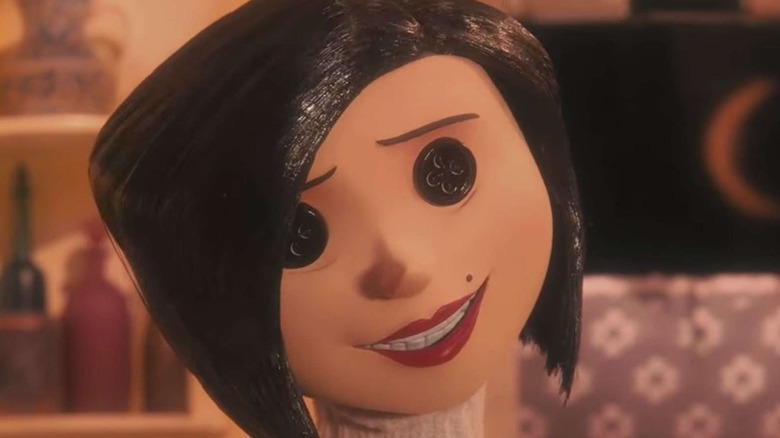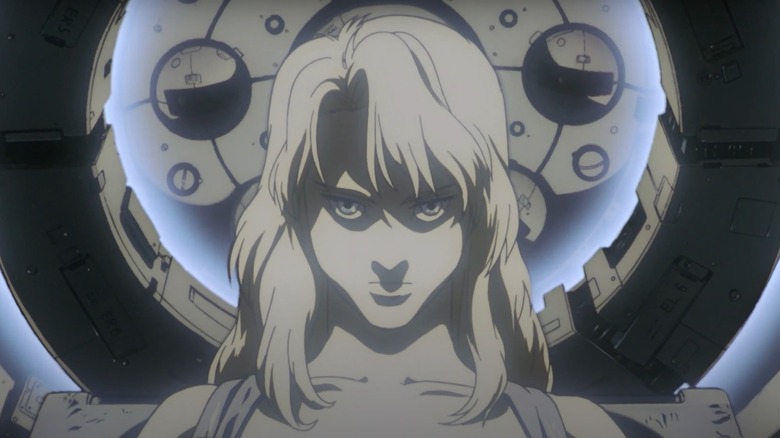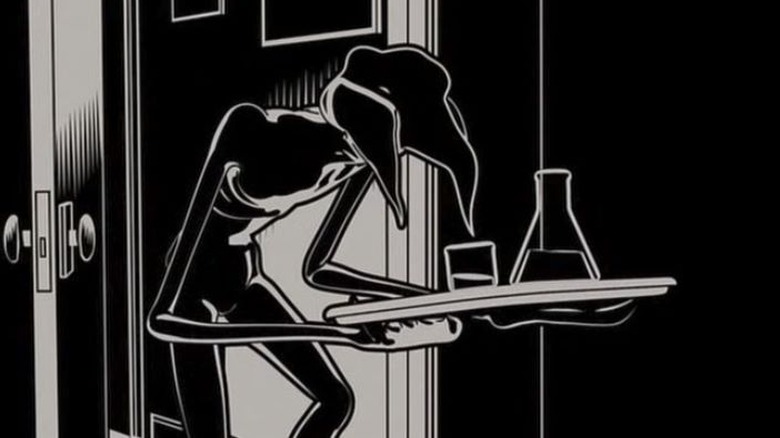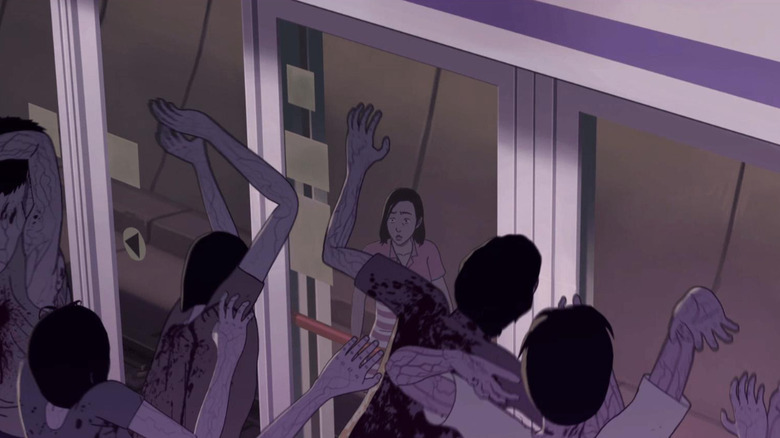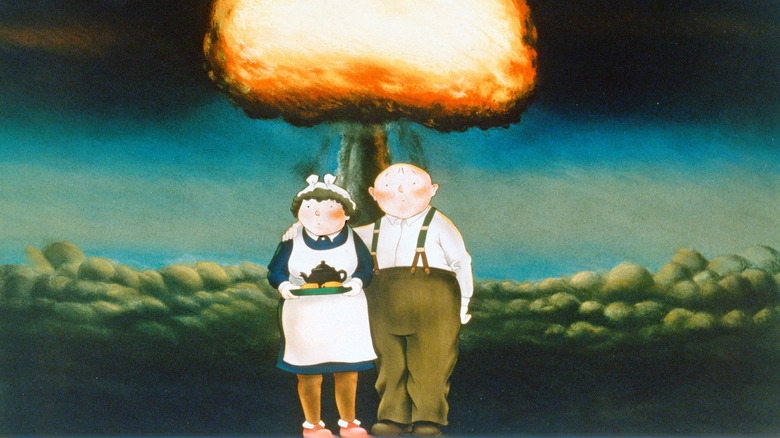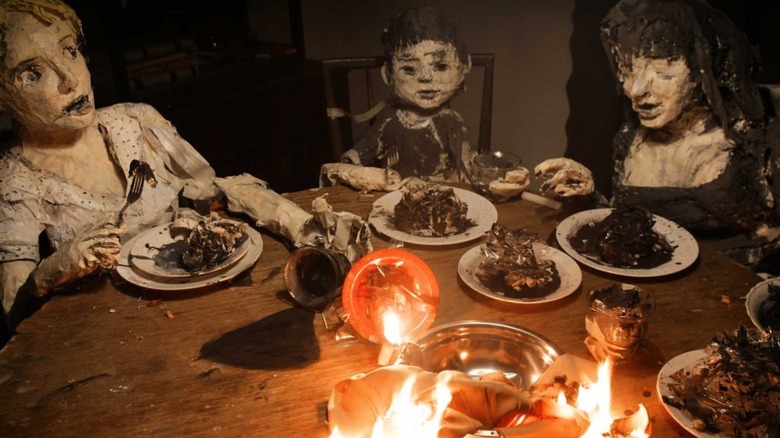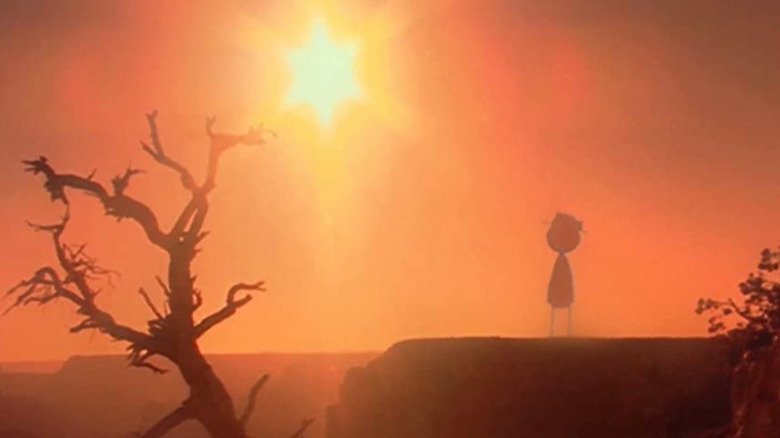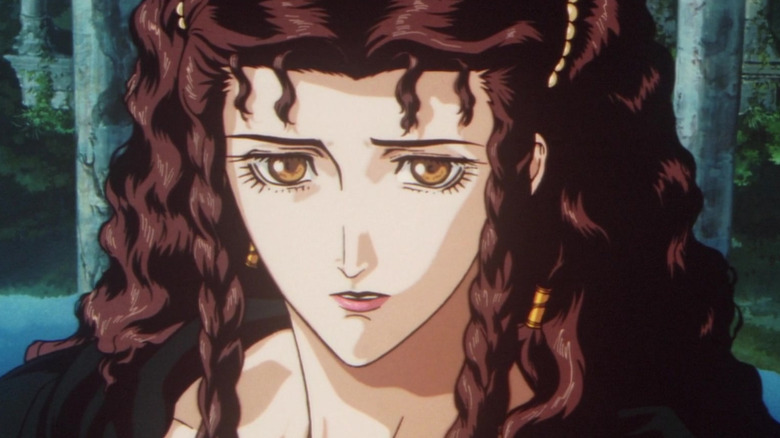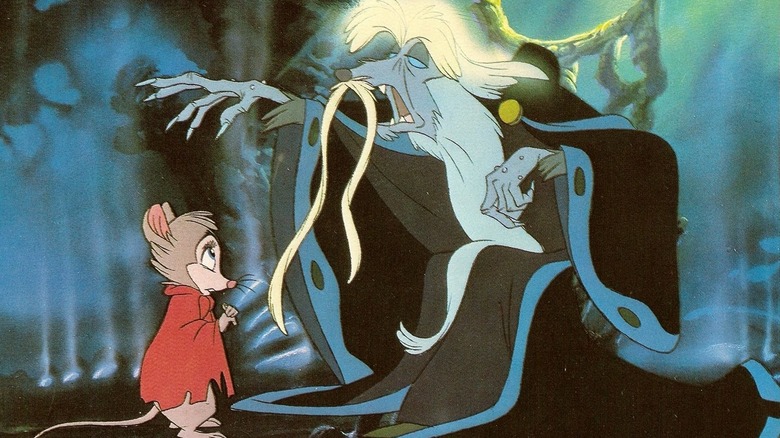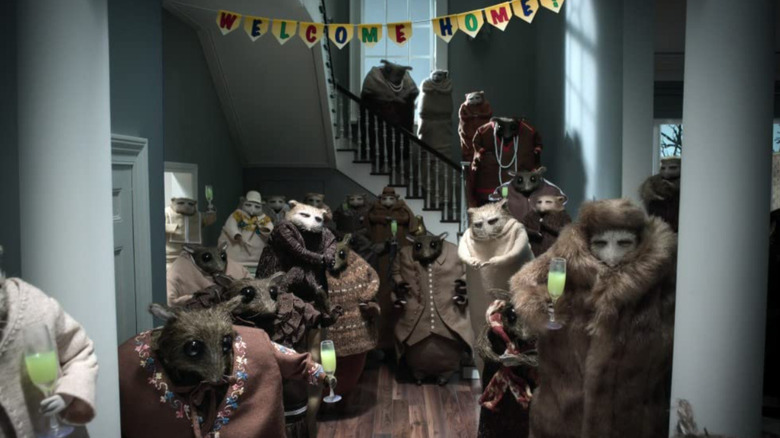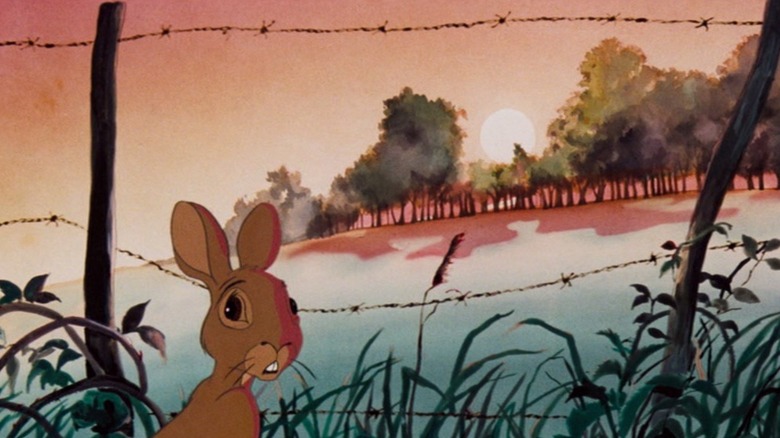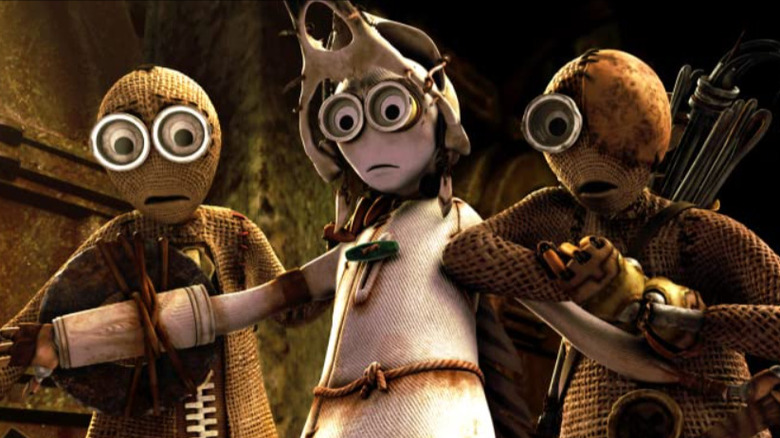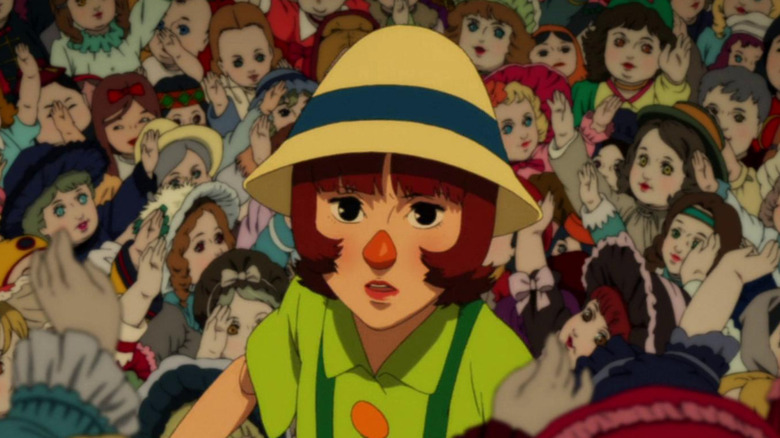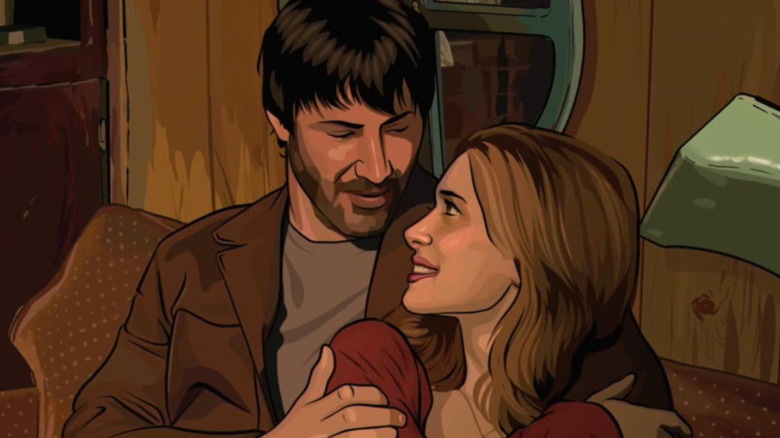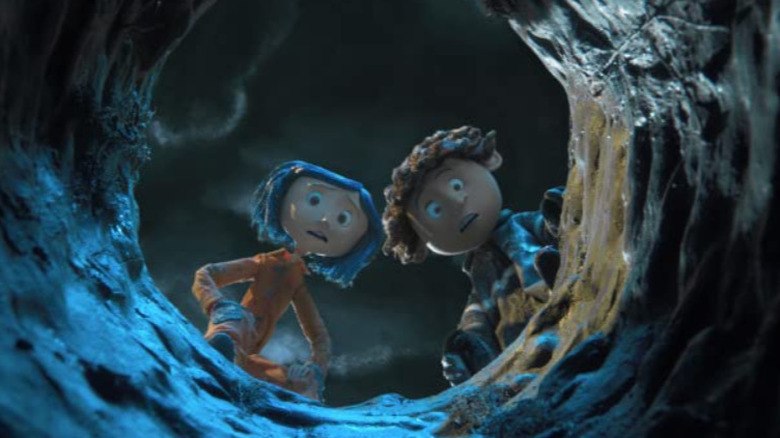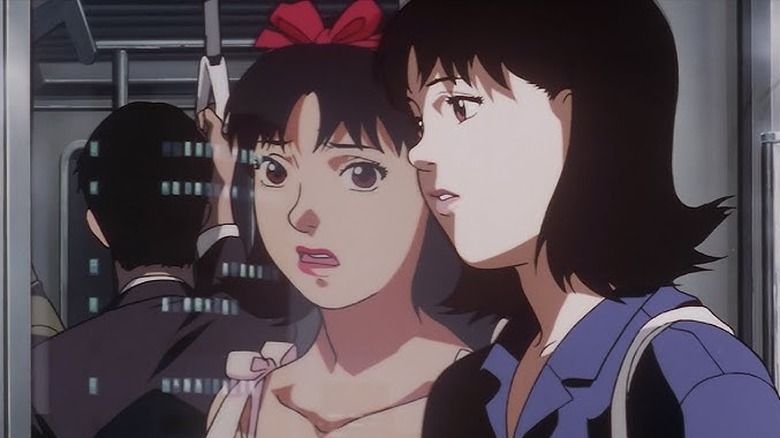Animated Movies Horror Fans Should Watch
The beauty of the horror genre is that it's wide and vast, encompassing various subgenres. There's social and psychological thrillers like "Get Out" and "Parasite," slashers like "Scream" and "Friday the 13th," hauntings like "The Shining," and monster movies like "The Thing." We often even find elements of horror infused in science fiction, fantasy, black comedy, and disaster films. This isn't just because our own specific, personal terrors give us our own unique perspective on the darker side of media. It's also because, at its core, horror is simply about the mood evoked. It's about the tension that lingers or the fears that resonate with us. As a result, we have a rich supply of horror-themed content at our disposal — including a fascinating collection of animated stories.
And so, in honor of this frequently overlooked world of horror movies, we present you with a curated list of animated tales that are definitely worth your time. From kid-friendly introductions to the genre and artsy (and often devastating) adult-oriented content, to horror comedies, existential horror, and the real-world horrors of war, there's something here for every kind of horror enthusiast.
Ghost in the Shell (1995)
Set in 2029 in the futuristic society of New Port City, Japan, Mamoru Oshii's "Ghost in the Shell" takes place in a world where people have learned how to replace organic human parts with cybernetic hardware. The film follows Public Security Section 9, a secret-police-like unit helmed by Major Motoko Kusanagi (voiced by Atsuko Tanaka) that focuses on cyber-based crime. For some, like Kusanagi, all that's left of her human existence is the brain encased in her cybernetic skull. While she sometimes hears "whispers" from her ghost (think consciousness here), she speculates whether even that part of herself is still human. As she tries to understand who — and what — she is, her team is tasked with tracking down a terrorist known only as the Puppet Master (voiced by Iemasa Kayumi), who has found a way to hack into world leaders' brains.
Fans of existential horror need not look any further than "Ghost in the Shell." With an added sprinkling of body horror and some thought-provoking ruminations on past human philosophies, this dark, cyberpunk, dystopian anime classic — adapted from Masamune Shirow's manga of the same name — introduces us to a world that is plummeting toward a significant technological singularity in which humans and machines are beginning to merge in unexpected ways. This causes us as viewers (and some of the characters) to question the very definition of personhood, what it means to be alive, and what it means to be real. It's one of the best anime movies ever made, and a must-see for horror fans.
Fear(s) of the Dark (2007)
The black-and-white French film "Fear(s) of the Dark" offers five different stories by five different directors, all exploring the concept of fear and ranging from traditional to 3-D animation. Throughout, we're also presented with intervals in which a woman's disembodied voice speaks of her own fears — talking about everything from small, anxiety-ridden moments to crushing depression — via a confessional monologue.
The first story centers on a man with a pack of vicious dogs he gleefully sets on other people. The second, notably created by Charles Burns, the same guy who penned the Harvey Award-winning graphic novel "Black Hole," sees a man who once captured a human-shaped beetle as a boy terrorized by insects as an adult. The third installment focuses on a young girl struggling with crippling nightmares sparked by a bully-induced tragedy. The fourth tale follows a boy who lost his uncle on a poaching trip and who believes his friend might be responsible, and the fifth follows a man seeking refuge in an old house during a blizzard. Unfortunately for him, this is where his real nightmare begins.
This anthology film got a lot of love online. Reddit user u/Tomahawkeye12 called the animation "striking and memorable," adding that the collection is a truly "creepy" one that has "made quite an impression." Though quieter and not quite as hard-hitting as our other recommendations, we consider "Fear(s) of the Dark" a perfect choice for fans of thoughtful, concept-driven horror who are looking to engage with some solidly dark animated content.
Seoul Station (2016)
Yeon Sang-ho's "Seoul Station," an animated prequel to his live-action zombie movie "Train to Busan," gives viewers some insight into how the zombie outbreak we see in the latter film erupts in South Korea. At the very start, we watch a dying man wander around Seoul Station, clutching his bloodied neck, and, well, we trust you know what comes next. From there, the narrative shifts its focus to young brothel runaway Hye-sun (voiced by Shim Eun-kyung), who is now living with her boyfriend Ki-woong (voiced by Lee Joon). They are struggling financially, and we see the couple arguing at the station over Ki-woong's horrific and unwelcome idea for how to ease their hardship.
Parting ways after their heated fight, the two characters are soon thrust into apocalyptic chaos via zombie slaughter and terror. While Hye-sun tries to navigate an even bleaker and more merciless world than the one she escaped, Ki-woong teams up with Suk-gyu (voiced by Ryu Seung-ryong), the man claiming to be Hye-sun's father, to try to survive the undead hordes and reunite with his girlfriend.
The Hollywood Reporter's Clarence Tsui praised the film for paying homage to the "traditions set by George A. Romero's rough-and-ready subversive zombie flicks," noting that "Yeon molds the gore and grotesquerie into admittedly understated social metaphors about hopelessness and alienation in a society ridden with inequality." And though it's not animated, for those who haven't yet seen it, we highly suggest watching "Train to Busan" afterward for another emotional rollercoaster of a horror movie.
When the Wind Blows (1986)
Set in Cold War-era Britain, and with a fascinating blend of traditional hand-drawn animation and early stop-motion, Jimmy Murakami's 1986 disaster movie "When the Wind Blows" (based on Raymond Briggs' 1982 comic book of the same name) follows the efforts Jim (John Mills) and Hilda (Peggy Ashcroft) take to survive in the face of nuclear war and the devastating fallout of a nuclear bomb. There's "pervasive sadness" throughout, as Horror Fuel warns us, but those who can push past that will find a rich story "filled with surprising heart and humor," even "among the encroaching horror." While often heavy-handed in its messaging, the visuals are still stunning, and the dialogue feels simultaneously absurd and mundane when juxtaposed against all the bleak destruction.
Our elderly couple use one of the "Protect and Survive" pamphlets (actually issued by the British government in 1980) to ready their cottage in the English countryside for an attack that they're told, via the radio, will take place in just three days. From there, our isolated protagonists wait, believing wholeheartedly that, after they do their part by hunkering down, someone will eventually come to save them. What's more is that David Bowie performed the title song, and Roger Waters of Pink Floyd composed the score. All of these distinctive parts add up to a pathos-driven, slow-burning gem of a movie that Reddit users like u/OhMyGodBearIsDriving believe embodies "The absolute unyielding horror of complete hopelessness."
The Wolf House (2018)
For lovers of surreal, artsy horror and twisted fairy tales, the critically acclaimed stop-motion film "The Wolf House" (it boasts a score of 96% on Rotten Tomatoes) is a must-see. This creepy and complicated subversion of "The Three Little Pigs" is presented as a sort of indoctrination video created by a German, cult-like settlement in Chile. It's worth noting that this deeply unsettling film is inspired by real world events — specifically, the horrors and atrocities committed in Colonia Dignidad, a colony founded by cult leader Paul Schäfer (via The Nation).
Directed by Cristóbal León and Joaquín Cociña, this Chilean picture full of haunting visuals centers on a young girl named Maria (Amalia Kassai), who's fled from an isolated community of religious nuts. With the Wolf at her back, Maria searches for sanctuary, ducking into the first house she sees. When she discovers that two pigs occupy the house, she decides to take them under her wing and teach them all she knows. What follows is a gradual transformation — both of the increasingly nightmarish house and of Maria and the two pigs. According to IndieWire's David Ehrlich, this is "the darkest animated movie ever made."
It's Such a Beautiful Day (2012)
"It's Such a Beautiful Day" is a lot of things. It's experimental. It's surreal. It's comedic. It's smart. It's tragic. It's heartwarming, but it's definitely not for children. We'd even go so far as to call it a near-perfect fantasy movie. And while it's inspirational, it's also, well, horrific. We've included it on our curated list because we suspect fans of horror comedy, existential horror, and true-to-life horror will all find something to like here. Essentially a three-part feature-length movie (each chapter was first released as a short film), the story follows a man named Bill who suffers crippling memory loss and (sometimes truly nightmarish) hallucinations caused by an unknown illness.
According to critic Laurence Barber, all you really need to know about "It's Such a Beautiful Day" (which also serves as the title of the third and final chapter) is that it "drags you into Bill's world and immerses you in the beauty and horror of his situation." Basically, creator Don Hertzfeldt uses simple illustrations and "aural and visual atmospheres" meant to "disorient" to depict the terrors that come with losing yourself, offering viewers a captivating and at times philosophical exploration of psychological trauma. It's the kind of film that sticks with you long after the credits have rolled.
Vampire Hunter D: Bloodlust (2000)
Perfect for vampire movie enthusiasts and anime fans alike, "Vampire Hunter D: Bloodlust" is that rare sequel that exceeds its predecessor. What's more is that you don't necessarily have to see 1985's "Vampire Hunter D" before checking this one out, as "Bloodlust" presents its audience with a completely self-contained narrative.
Based on the third novel in Hideyuki Kikuchi's "Vampire Hunter D" book series, this second film installment finds the titular dhampir — a being with both vampire and human blood running through his veins — hired to rescue a wealthy man's human daughter from the clutches of vampire noble Baron Meier Link. Dead or alive, Charlotte's father wants her back. After ensuring a sizable reward, D agrees to retrieve the man's daughter, but complications ensue pretty quickly when Charlotte's brother recruits his own bounty hunters to complete the task. As the group embarks on a bloody quest to save their presumed damsel in distress, they learn the situation is not what it seems.
"Vampire Hunter D: Bloodlust" has long been a fan favorite. Redditor u/Scarcecrows considers it to be an "absolute gothic masterpiece," praising the film for having "some of the most creative spins on genre monster standards" as well as "some glorious creations of its own." And, as Bloody Disgusting's Ryan Larson points out, the film ticks a lot of boxes, masterfully blending "a slew of genres including fantasy, Western, steampunk, Victorian romance, occult, and horror."
The Secret of NIMH (1982)
Due to the nightmarish imagery, Evil Geeks' Lilith Assisi gave "The Secret of NIMH" a "horror of horrors status," while Cinepunx writer Justin Lore has suggested that one disturbing scene depicts a kind of "psychedelic transformation" that steps into "Cronenberg territory." All that is to say, Don Bluth's 1982 classic makes this list because it serves as a fantastic, kid-friendly introduction to horror-themed content.
Based on "Mrs. Frisby and the Rats of NIMH," a children's novel written by Robert C. O'Brien, this animated tale follows the recently-widowed field mouse Mrs. Brisby (Elizabeth Hartman) as she scrambles to move her children from their cinder block home in the field before plowing season begins on the Fitzgibbons' farm. In the opening scene we learn that her late husband died during a failed attempt to poison the farmer's cat, Dragon, making things bleak and dire right from the start. Mrs. Brisby's situation only grows grimmer when one son comes down with pneumonia and must stay inside for at least three weeks or risk death. With time running out, the increasingly desperate widow seeks guidance from the Great Owl, who tells her to visit Nicodemus, leader of the highly intelligent, refugee rats currently dwelling under the rose bush.
Featuring rising terror, death, and some upsetting moments regarding animal cruelty and testing, this is definitely not a Disney film. Reddit user u/largeheartedboy hit the nail on the head when they said that this underrated animated flick "leaves basically every kid who sees it with a lingering dread."
The House (2022)
The AV Club's Noel Murray calls "The House," Netflix's adult, stop-motion anthology film, a "quasi-horror picture" with a "haunting score," adding that it is "more of a quietly arty creep-out than a full-on shocker." With three separate stories set in the same house in different times and realities (written by Enda Walsh but helmed by different directors), this British creation offers lingering dread, grotesque Lynchian and Cronenberg body horror, and one unifying poem built from each segment's title card that's open to interpretation.
The first story, which starts with the line "And heard within, a lie is spun," follows a poverty-stricken family of four invited by a mysterious architect to live in the titular house and never have to worry again. When her parents begin acting strange after eating food provided by their new butler and the house begins shifting, with rooms and stairs disappearing, daughter Mabel soon learns there's definitely cause to worry.
In the second segment, which begins with "Then lost is truth that can't be won," a sleazy, obsessive developer preps the place for an open house before discovering an overwhelming infestation he just can't control. And in the last installment, which is the least horror-driven and starts with the line "Listen again and seek the sun," landlord Rosa, living in a post-apocalyptic world in which sea levels have reached dangerous, destructive levels, desperately clings to the house despite the fact that it's falling apart.
This beautifully rendered anthology film is fully deserving of its near-perfect 97% Rotten Tomatoes score.
Watership Down (1978)
For the horror enthusiast parents whose kids enjoyed "The Secret of NIMH" and are ready to graduate to slightly more mature childhood nightmare fodder, we suggest Martin Rosen's gorgeously animated "Watership Down," which is far scarier and far more disturbing than many modern-day horror endeavors. Adapted from Richard Adams' 1972 novel, this animal-centric tale, as The Independent's Ed Power notes, "arguably traumatized an entire generation." The Guardian's Phil Hoad even claims to "have dim memories of fleeing from a dark cavern of a Newcastle cinema, desperate for bright air and parental comfort."
The story follows a warren of rabbits who flee their home after seer Fiver (voiced by Richard Briers) has a horrific, blood-soaked vision of death and danger. With their small patch of the world no longer safe from human destruction, Fiver recruits his brother Hazel (voiced by the late John Hurt) to help him convince the chief to evacuate the rabbits. Unfortunately, their leader's refusal to accept the reality of impending doom, combined with his staunch refusal to let those now eager to leave actually leave, force the brothers to gather up their frightened brethren on their own, escaping the warren and embarking on a search for new sanctuary — but the journey ahead proves dark and foreboding.
Featuring some terrifying imagery and some incredibly rich mythology, "Watership Down" is an animated classic that still hits as hard today as it did in 1978. Reddit users like u/DesignOramas "still remember this beautiful yet horrifying movie like it was yesterday," fondly claiming they had "nightmares for years."
9 (2009)
If you've never seen Shane Acker's computer-animated, post-apocalyptic movie "9," we highly suggest this unique and steampunky feature-length adventure, which was based on the Academy Award-nominated short of the same name. If you're a fan of Tim Burton (who served as a producer) then you're bound to love it. The film truly embraces its horror elements. The New York Times' A.O. Scott praised the "strange, sinister, and brilliantly realized landscape," which is full of "allusions to the histories of painting, animation, fantastic literature, and 20th century totalitarianism."
In the name of progress, a 1940s dictator forces a scientist to create a robot with artificial intelligence. In reality, the dictator plans to use this invention as a weapon, and before our poor scientist can infuse the A.I. with a soul, the dictator takes the creation and turns it into a war machine capable of obliterating his enemies. The problem is, that lack of a soul causes the Fabrication Machine to program the dictator's war machines to eradicate all life on Earth — human, animal, and plant. In response to the devastation, our dying scientist uses alchemy to create nine little "Stitchpunk" ragdolls, each infused with a piece of his own soul. And that's where the real story begins.
As the scientist takes his last breath, 9 (voiced by Elijah Wood) takes his first. Soon, our protagonist is venturing into a decimated city, where he meets others like him and learns they must band together to battle against the robotic monsters hellbent on destroying them.
Paprika (2006)
"Paprika," a psychological thriller full of surrealist dreamscapes, is the last feature-length film the legendary Satoshi Kon directed before his death. Based on Yasutaka Tsutsui's 1993 novel of the same name, the narrative centers on the employees of a research facility. Before the events of the film, Doctor Kōsaku Tokita created a device called the DC Mini, a machine that gives the user the ability to enter the dreams of others, to share dreams, and even to create nightmares. Viewing the tech as a breakthrough for psychiatric treatment, our protagonist, research psychologist Doctor Atsuko Chiba, has adopted the persona "Paprika" in the dream world. She uses the device — illegally — to help others outside of the facility, like Detective Toshimi Konakawa, who's haunted by a case he can't seem to solve.
Early on, the team learns someone from inside the facility has stolen a DC Mini for nefarious purposes, and in the wake of the theft, the lines between reality and fantasy begin to blur, bringing about nonsensical chaos, terror, and destruction. "There's something sinister about the dreamscapes in 'Paprika,' fluidly rendered in both hand-drawn and 3-D animation, which may seem peculiar for moviegoers used to more benign animated fantasies," The New York Times' Manohla Dargis said, praising the "sense of unease" that Kon brings to the screen. Bright and colorful, but also absurd and terrifying, we'd call "Paprika" the better version of "Inception."
A Scanner Darkly (2006)
"A Scanner Darkly" is a cult classic from the mind of Richard Linklater, the Oscar-nominated director of "Boyhood" and the "Before" trilogy. The film is "haunting, dystopian science fiction at its best" according to The Spool's Justin Harrison. "A big part of the reason why it works so well is that, even in the depths of hallucinatory horror, it's very much a Richard Linklater film."
With a star-studded cast featuring Keanu Reeves, Winona Ryder, Robert Downey Jr., and Woody Harrelson, this dark, rotoscoped thriller introduces us to a world in which nearly 20% of the American population is addicted to a dangerous hallucinatory drug called Substance D. The U.S. government, responding to the rampant use of Substance D, has transformed into an oppressive, high surveillance police state in which a citizen's every move is scrutinized. On top of that, undercover agents — all of whom wear "scramble suits" that change their appearance and keep their real identities hidden — work to infiltrate the intricate underbelly of the Substance D drug world.
One such agent is Bob Arctor (Reeves), codename "Fred." The problem is, Bob has developed his own addiction to Substance D. As we follow Bob through his hallucinations, things only get more complicated and confusing — in a good way. Linklater offers a disturbing vision of the future that horror fans will love.
Coraline (2009)
No horror-themed list would be complete without a doppelgänger movie, and Henry Selick's stop-motion film "Coraline" is delightfully dark. This creepy tale features disturbing imagery and unsettling body horror — but it's rich with other horrors too. "Although the medium of [the] film has an effect in removing the input of visual imagination, presenting a truly nightmare-inducing, insectoid villain toward the end, it could be argued that the subtext of psychology creates more horror," said Horror Obsessive's Robin Moon.
We meet the titular character (voiced by Dakota Fanning) while she's still trying to adjust to a new, lonely life at the Pink Palace Apartments. After she's gifted a doll that looks exactly like her — except for the fact that it has buttons for eyes — by the landlady's grandson, Coraline finds herself drawn to a small door in the living room. It turns out this door serves as a portal to a parallel world where button-eyed versions of her parents, rather than being negligent and too work-obsessed to notice their daughter's struggles, dote on her. Though she relishes the attention at first, it soon becomes clear that there's something a lot more sinister going on. Like, you know, the monster lurking in the shadows that's dead-set on claiming Coraline's soul.
Perfect Blue (1997)
Satoshi Kon's masterpiece "Perfect Blue" is one of the greatest anime films of all time. It was a hit with anime fans when it dropped back in 1997 and is still creeping new viewers out to this day. "Never have I seen a movie that has gotten under my skin and messed with my head as much as 'Perfect Blue,'" Redditor u/New_Mycologist_3002 posted in 2022. "This is quite possibly one of the most terrifying movies I have ever seen despite being animated."
Full of beautiful, surprising, and horrific visuals, as well as simmering, slow-growing tension, the film follows a former J-pop star as she attempts to build an acting career. At the start, idol Mima Kirigoe (voiced by Junko Iwao) announces her retirement from CHAM!, the music group that brought her fame, to a crowd of adoring fans. But the decision — along with her determination to shed her innocent persona for a more mature one — comes with its costs, including one dangerous stalker.
While she secures a small role in a popular detective drama, she continues to struggle with the career change. That stress worsens when she's led (via a fan letter) to a website called "Mima's Room," in which an unknown person — who just so happens to know every little thing about her — writes intimate confessional posts. Soon, Mima's ability to distinguish between what is real and what is not deteriorates. As she begins hallucinating, she starts to question whether the person writing those posts is the real Mima.
Based on Yoshikazu Takeuchi's novel "Perfect Blue: Complete Metamorphosis," and serving as clear inspiration for movies like "Black Swan," this provocative and near-flawless film is not to be missed.
